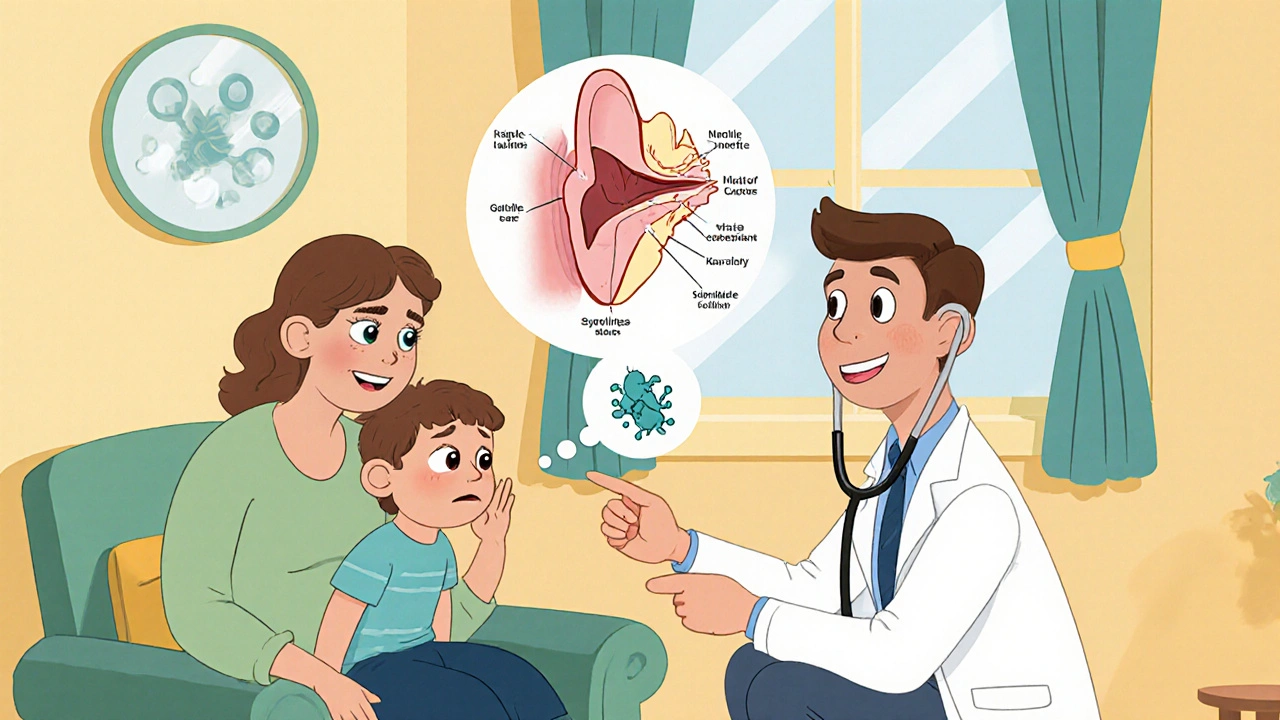Clarithromycin Dosage Calculator
Calculate Your Dosage
Dosage Results
Dosage Recommendation:
Duration: 10 days
Frequency: Every 12 hours
Important Instructions: Take with a full glass of water. For children, use oral suspension with a calibrated measuring device. Complete the full 10-day course even if symptoms improve.
When your child or you develop an ear infection, the first question is often “which antibiotic will clear it up fastest?” While amoxicillin is the go‑to for many cases, doctors sometimes turn to clarithromycin ear infection therapy, especially when the usual suspects don’t work. This guide breaks down everything you need to know about using clarithromycin for ear infections - from how it works and who should take it, to dosing, side effects, and how it stacks up against other antibiotics.
What is Clarithromycin?
Clarithromycin is a macrolide antibiotic that interferes with bacterial protein synthesis. It binds to the 50S ribosomal subunit, halting the growth of susceptible bacteria. First approved in the early 1990s, clarithromycin quickly became a staple for respiratory and skin infections, and it’s also effective against many organisms that cause middle‑ear (otitis media) infections.
How Clarithromycin Works Against Ear Infections
Ear infections are usually triggered by bacteria that have colonized the middle ear following an upper‑respiratory infection. The most common culprits are Streptococcus pneumoniae, Haemophilus influenzae, and Moraxella catarrhalis. Clarithromycin targets these gram‑positive and some gram‑negative bacteria by stopping protein production, which prevents the organisms from multiplying and allows the body’s immune system to clear the infection.
When Is Clarithromycin Prescribed for Ear Infections?
- Allergy to penicillins or amoxicillin - If a patient reports a severe allergic reaction, doctors often skip beta‑lactam antibiotics.
- Resistance to first‑line agents - Rising rates of beta‑lactamase‑producing H. influenzae can render amoxicillin ineffective.
- Persistent or recurrent otitis media - When infections keep coming back despite standard therapy, a broader‑spectrum macrolide may be tried.
It’s important to note that clarithromycin is not the first choice for uncomplicated acute otitis media (AOM) in most guidelines. Its use is usually reserved for the situations above or when a culture confirms a susceptible organism.

Dosage Guidelines
Dosage depends on age, weight, and severity of infection. Below are the most common regimens.
Adults
- Standard dose: 500 mg orally every 12 hours for 7-10 days.
- Severe infection or high‑risk patients: 1000 mg daily (500 mg BID) for 10 days.
Children (6 months to 12 years)
Weight‑based dosing is the norm. The typical dose is 7.5 mg/kg every 12 hours, not exceeding 250 mg per dose, for a total of 10 days. For example, a 20‑kg child would receive 150 mg twice daily.
Always use an oral suspension that’s calibrated for accurate measurement. A pharmacist can prepare a 125 mg/5 mL suspension if a commercial preparation isn’t available.
Side Effects and Safety Considerations
Like any medication, clarithromycin carries a risk profile. The most frequent adverse events are:
- Gastrointestinal upset - nausea, vomiting, abdominal pain, or diarrhea (often mild).
- Altered taste - a metallic or bitter sensation reported by up to 5 % of users.
- Headache or dizziness.
Serious but rare events include:
- QT interval prolongation - can lead to heart rhythm disturbances, especially in patients with existing cardiac disease or those taking other QT‑prolonging drugs.
- Hepatotoxicity - marked elevation of liver enzymes; monitor patients with pre‑existing liver disease.
- Severe allergic reactions - anaphylaxis is extremely uncommon but possible.
Pregnant or breastfeeding women should discuss risks with their provider; while animal studies show no teratogenicity, human data are limited.
Drug Interactions You Shouldn’t Ignore
Clarithromycin is a strong inhibitor of the cytochrome P450 enzyme CYP3A4. This means it can raise blood levels of several other drugs, potentially causing toxicity.
- Statins (e.g., simvastatin, lovastatin) - increased risk of muscle damage.
- Warfarin - may enhance anticoagulant effect; monitor INR closely.
- Ergot derivatives (e.g., ergotamine) - danger of severe vasospasm.
- Anticonvulsants - clarithromycin can increase serum concentrations of carbamazepine.
- Other macrolides - avoid combining with erythromycin or azithromycin due to additive QT prolongation.
If you’re on any of these medications, your doctor may adjust doses or choose an alternative antibiotic.

Comparing Common Antibiotics for Otitis Media
| Antibiotic | Class | Typical First‑Line Use | Common Side Effects | Key Contra‑indications |
|---|---|---|---|---|
| Amoxicillin | Penicillin | First‑line for uncomplicated AOM | Diarrhea, rash | Penicillin allergy, high‑level beta‑lactamase organisms |
| Clarithromycin | Macrolide | Allergy to penicillin or amoxicillin‑resistance | GI upset, taste change, QT prolongation | CYP3A4‑interacting drugs, severe liver disease |
| Azithromycin | Macrolide | Alternative when short course needed | Diarrhea, nausea | Same CYP3A4 interactions as clarithromycin |
| Cefdinir | Cephalosporin | Second‑line for beta‑lactamase producers | Stool discoloration, rash | Severe cephalosporin allergy |
| Clindamycin | Lincosamide | Anaerobic coverage when needed | Clostridioides difficile infection | History of C. diff infection |
The table shows that clarithromycin shines when a patient can’t tolerate beta‑lactams or when resistant strains are suspected. However, its interaction profile is heavier than amoxicillin’s, so weighing benefits against risks is crucial.
How to Take Clarithromycin Effectively
- Take the medicine with a full glass of water.
- If you experience stomach upset, you can take it with food, but avoid dairy products within 2 hours as calcium may slightly reduce absorption.
- Complete the entire prescribed course, even if symptoms improve after a few days.
- Do not crush or chew extended‑release tablets; swallow them whole.
- Store liquid suspension in the refrigerator and discard after the expiration date on the label.
Missing a dose? Take it as soon as you remember, unless it’s almost time for the next scheduled dose. In that case, skip the missed one and continue with your regular schedule - don’t double up.
Frequently Asked Questions
Can I use clarithromycin for chronic ear infections?
Chronic otitis media often involves biofilm‑forming bacteria that are less responsive to macrolides. In most cases, ENT specialists recommend a combination of topical antibiotics and possibly surgical ventilation rather than a systemic macrolide.
Is clarithromycin safe for children under 6 months?
Safety data for infants younger than 6 months are limited. Pediatricians usually avoid prescribing clarithromycin to this age group unless the potential benefit outweighs the risk, and they will monitor liver function closely.
What should I do if I develop a rash while on clarithromycin?
Stop the medication immediately and contact your healthcare provider. A rash could signal an allergic reaction that may progress to more serious symptoms.
Can clarithromycin interact with over‑the‑counter cold medicines?
Many OTC cold remedies contain dextromethorphan or antihistamines, which are generally safe. However, avoid combination products that include pseudoephedrine if you have high blood pressure, and always check with a pharmacist for hidden CYP3A4 inhibitors.
How long does it take for symptoms to improve?
Most patients notice reduction in pain and fever within 48‑72 hours, but the full bacterial clearance often requires the complete 7‑10‑day course.
Armed with the facts above, you can discuss clarithromycin confidently with your doctor and make an informed choice when treating ear infections.







Rajesh Myadam
Thanks for putting together such a thorough guide. I appreciate how you broke down the dosage differences for kids and adults – that can be confusing for many parents. It’s also good to see the warning about QT prolongation, as I have a family member on a heart medication. I’ll definitely bring up the drug interaction list with my pediatrician if we ever need an alternative to amoxicillin. Keep the info coming, it’s genuinely helpful.
Andrew Hernandez
I liked the clear table comparing antibiotics it makes choosing easier.
Kate McKay
Great summary! For anyone feeling overwhelmed, remember that the most important thing is completing the full course, even if you feel better after a couple of days. Also, if you notice any rash or unusual side effects, stop the meds and call your doctor right away. The weight‑based dosing for kids can be tricky, so double‑check the calculations with your pharmacist.
Demetri Huyler
Honestly, the whole macrolide hype is overblown. If you’re not allergic to penicillins, you’re better off sticking with the tried‑and‑true amoxicillin. All these “exceptions” sound like a way for pharma to push pricier drugs onto unsuspecting patients. Let’s not forget that resistance patterns vary by region, so a blanket recommendation for clarithromycin feels presumptuous.
JessicaAnn Sutton
While the article is comprehensive, it neglects to emphasize the ethical responsibility of prescribing antibiotics only when truly necessary. Overprescription contributes to antimicrobial resistance, a public health crisis that cannot be ignored. Clinicians must weigh the benefits against the societal cost, especially when alternatives exist. The guide would benefit from a stronger stance on stewardship.
Matthew Hall
It’s funny how every “new” antibiotic comes with a side‑effect warning that seems designed to scare you. I’m convinced there’s a larger agenda at play – the pharma giants want us to stay dependent on their latest products. The QT‑prolongation thing? Most people never even get an ECG. Trust your gut, not the corporate label.
Vijaypal Yadav
From a pharmacokinetic perspective, clarithromycin’s inhibition of CYP3A4 can lead to significant plasma concentration spikes of co‑administered drugs. For instance, simvastatin levels may increase 5‑fold, raising the risk of rhabdomyolysis. It’s essential to review the patient’s medication list before initiating therapy, especially in polypharmacy scenarios.
Ron Lanham
Let me walk you through why clarithromycin, despite its occasional utility, should not be your first line of defense against otitis media. First, the drug’s spectrum, while broad, does not adequately cover beta‑lactamase–producing Haemophilus influenzae, a common pathogen in pediatric ear infections. Second, the macrolide class is notorious for fostering resistance through ribosomal methylation mechanisms, which can render not only clarithromycin but also azithromycin ineffective. Third, the interaction profile is extensive; inhibition of CYP3A4 means that patients on statins, certain anticoagulants, or antiepileptics may experience toxic plasma levels, leading to potentially serious adverse events. Fourth, the QT interval prolongation risk, albeit low in absolute terms, is clinically significant for patients with underlying cardiac conditions or those concurrently taking other QT‑prolonging agents. Fifth, the hepatic metabolism of clarithromycin can stress the liver, particularly in individuals with pre‑existing hepatic impairment, requiring regular monitoring of liver enzymes. Sixth, the cost factor cannot be ignored; clarithromycin is often more expensive than amoxicillin, creating an unnecessary financial burden for families. Seventh, the standard dosing schedule-twice daily for a minimum of seven days-can affect adherence, especially in children who may dislike the taste of the suspension. Eighth, the side effect profile includes gastrointestinal upset in a sizable proportion of patients, which can exacerbate dehydration in young children. Ninth, the use of clarithromycin may mask the true etiologic agent, delaying appropriate culture‑guided therapy. Tenth, guidelines from major pediatric societies continue to recommend amoxicillin as the first‑line agent, reserving macrolides for documented allergies or resistance. Eleventh, the notion that clarithromycin is a “safer” alternative in penicillin‑allergic patients overlooks the fact that cross‑reactivity is rare, and desensitization protocols exist for many. Twelfth, the drug’s impact on the microbiome is more profound than that of beta‑lactams, potentially leading to dysbiosis and subsequent gastrointestinal complications. Thirteenth, there is a lack of robust evidence supporting clarithromycin’s superiority in treatment outcomes for uncomplicated acute otitis media. Fourteenth, healthcare providers should prioritize antimicrobial stewardship, reserving broader‑spectrum agents for truly refractory cases. Finally, patient education is paramount: families need to understand why amoxicillin remains the cornerstone of therapy and why clarithromycin is a fallback, not a default.
Deja Scott
The dosage chart for children is especially useful. Remember to use a calibrated syringe for the suspension to avoid under‑dosing.
Mahesh Upadhyay
Clarify that the drug isn’t ideal for infants under six months – the data are limited.
Sebastian Green
I’m grateful for the clear warning about liver monitoring. It’s something many overlook.
Wesley Humble
While the article is exhaustive, it could benefit from a summarized bullet‑point list at the end for quick reference. Additionally, a brief note on the potential for drug‑drug interactions with commonly prescribed antihistamines would be valuable. 😊
Alex Pegg
Interesting take, but I think the emphasis on “alternative” antibiotics downplays the importance of following established clinical guidelines. A balanced approach that respects both patient safety and evidence‑based practice would serve readers better.